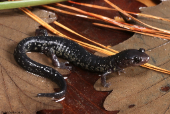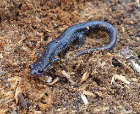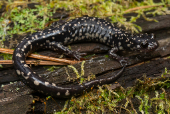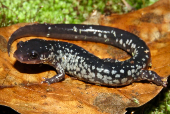South Carolina Slimy Salamander (Plethodon variolatus)
Description: Plethodon variolatus is a small salamander species with a total length of approximately 121 mm. Individuals have a snout to anterior vent length between 57 mm and 59 mm. Male individuals have a small, rounded mental gland. The head is slightly longer than it is wide, and the head is approximately five times smaller than the snout-vent length. Plethodon variolatus has a slender body with 16 costal grooves. The forelimbs are as long as the head. The hind limbs are slightly longer than the forelimbs. The third toe is significantly longer than the first toe. The tail of P. variolatus is approximately as long as the snout to anterior vent length. Plethodon variolatus has distinguishable white and brass-colored fleckings along their sides and dorsal surface.
Habitat: This species inhabits mixed hardwood forests, bottomland forests, and longleaf pine savannas. It prefers thick, damp woods where the ground is littered with debris. This species appears to avoid low, sandy areas that support palmetto and pine flatwoods. Individuals may use shrew burrows as retreats. It is frequently found in areas that have undergone prescribed burns, although unburned areas are always nearby so it is possible the species seeks refuge in the unburned sites.
Range: This species occurs in the southern Atlantic Coastal Plain of South Carolina and eastern Georgia.
Found in these States:
GA |
SC
Diet: Unknown, but as with other Plethodon species, feeding likely takes place at night under moist conditions. Prey items likely include a range of invertebrates, especially insects.
Reproduction: Eggs are laid on land. Common egg-laying locations include rotting tree stumps, underground, or in rock crevices.
Status: Listed as Least Concern in view of its relatively wide distribution, and because it is unlikely to be declining at such a rate as to warrant a threatened listing.
»» Kingdom: Animalia - Animals
»» Phylum: Chordata - Chordates
»» Subphylum: Vertebrata - Vertebrates
»» Class: Amphibia - (Amphibians)
»» Order: Caudata - Salamanders
»» Family: Plethodontidae - Lungless Salamanders
»» Genus: Plethodon
»» Species: Plethodon variolatus - South Carolina Slimy Salamander
This article uses material from the Wikipedia article "South Carolina Slimy Salamander", which is released under the Creative Commons Attribution-Share-Alike License 3.0. Content may have been omitted from the original, but no content has been changed or extended.
|













